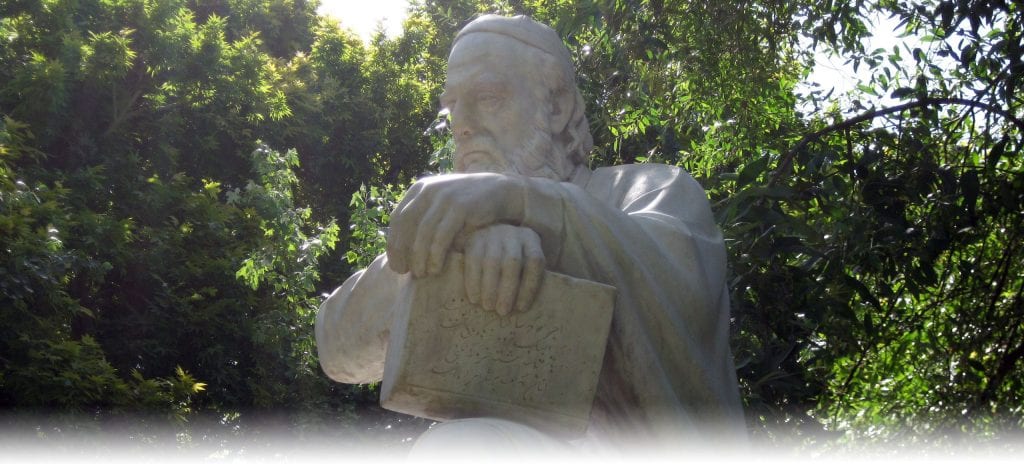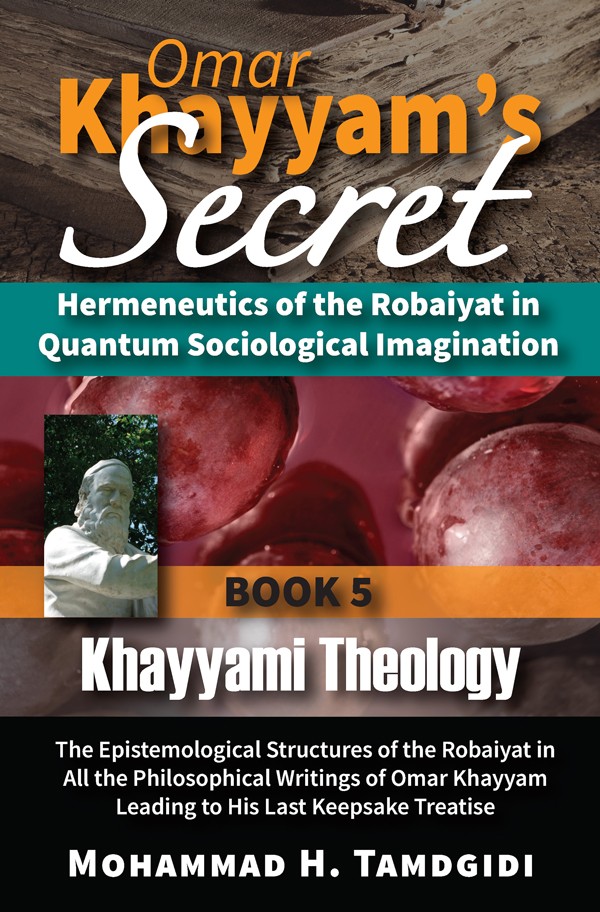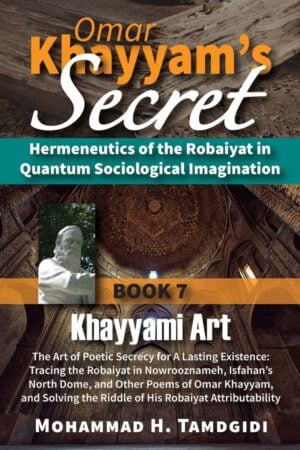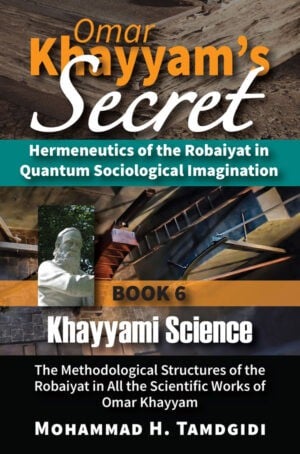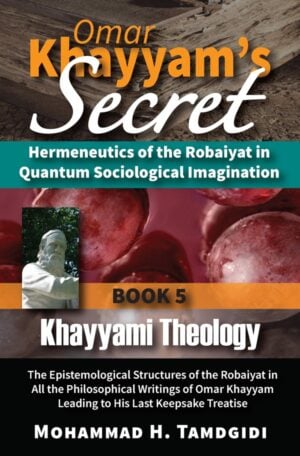Book Section: CHAPTER IV — Part 2 of Omar Khayyam’s Treatise on Existence Addressed to Abu Taher Regarding Attributes: The Arabic Manuscript and Updated Persian and New English Translations, Followed by Textual Analysis — by Mohammad H. Tamdgidi
$20.00
This essay titled “Part 2 of Omar Khayyam’s Treatise on Existence Addressed to Abu Taher Regarding Attributes: The Arabic Manuscript and Updated Persian and New English Translations, Followed by Textual Analysis” is the fourth chapter of the book Khayyami Theology: The Epistemological Structures of the Robaiyat in All the Philosophical Writings of Omar Khayyam Leading to His Last Keepsake Treatise, which is the fifth volume of the twelve-book series Omar Khayyam’s Secret: Hermeneutics of the Robaiyat in Quantum Sociological Imagination, authored by Mohammad H. Tamdgidi.
Description
Abstract
This essay titled “Part 2 of Omar Khayyam’s Treatise on Existence Addressed to Abu Taher Regarding Attributes: The Arabic Manuscript and Updated Persian and New English Translations, Followed by Textual Analysis” is the fourth chapter of the book Khayyami Theology: The Epistemological Structures of the Robaiyat in All the Philosophical Writings of Omar Khayyam Leading to His Last Keepsake Treatise, which is the fifth volume of the twelve-book series Omar Khayyam’s Secret: Hermeneutics of the Robaiyat in Quantum Sociological Imagination, authored by Mohammad H. Tamdgidi.
Omar Khayyam’s “Resaleh dar Vojood” or “رساله در وجود” (“Treatise on Existence”) (رساله فى اوصاف الموصوفات (رسالة فى الوجود)), also known variously as “Treatise on the Study of Attributes,” or “Treatise on the Attributes of the Attributed,” is one of the more well-known—though not necessarily more widely-studied in recent times—writings of Khayyam (AD 1021-1123) that was even mentioned by Beyhaqi in his biographical entry on Khayyam in Tatemmat Sewan el-Hekmat (Supplement to the Chest of Wisdom). It was specifically mentioned in that entry along with the treatise we studied in the second chapter of this volume, “Resalat fi al-Kown wa al-Taklif” (“Treatise on the Created World and Worship Duty”).
Since this treatise has the customary prayers to God both at the beginning and the end (in various extant copies of its manuscripts), it is safe to regard it as having been an independent piece of writing.
However, it would be wrong to consider it as one standing alone, since in the text of the treatise itself Khayyam himself specifically refers to two other writing (one even referred to as “fasl” or chapter) as being a part of the discussion expanding one or another aspect of it.
One was a treatise he had already written dealing with the topic “The Necessity of Contradiction” (one we studied in the previous chapter of this book), and another was mentioned at its very end as a “chapter” or “fasl” to follow his treatise on existence, one that Tamdgidi argues and shows is the treatise commonly known as the “Treatise on the Light of Intellect on the Subject Matter of Universal Science,” to be studied in the next chapter of this book.
Tamdgidi reports having benefited from Gholamreza Jamshidnejad Avval’s translation into Persian of Khayyam’s “Treatise on Existence” originally written in Arabic. However, he notes having found a need to rethink aspects of that translation prose while using it to translate the treatise into English for this chapter. Consequently, TamdgidI found it more helpful to translate the treatise anew back into Persian, which is presented in the chapter.
Credit for the original translation of this essay into Persian goes to Jamshidnejad Avval, however, despite the corrections and rethinking that became necessary as a result of Tamdgidi’s effort, including that when consulting the original handwritten manuscript to make some corrections to the Arabic original of the text being translated.
Tamdgidi has also compared at least three different variations of the manuscripts that are extant for this treatise and of which he has copies, and offers what he could find most legibly written without brackets, and the variations in the curved brackets. Instead of offering the variations in separate footnotes or endnotes, he includes them in curved brackets, so the reader can readily see the textual options available with minimal effort.
It should by now be clear to the readers of this series that the topic of existence was the most central theme of Khayyam’s philosophical and theological writings and, one may confidently argue, of his life and works. In the treatise we have studied in this chapter also we find him exploring the topic of existence, in particular focusing on the nature of attributes and on “existence” itself as one of such attributes, and how they can be properly understood.
The reason Khayyam is so focused on the topic of attributes may seem tangential and accidental to his overall intellectual project. However, as Tamdgidi argues in the chapter and this volume such a preoccupation was essential to his life’s work, and in particular to his approach to poetry as the most powerful means of communicating his spiritually embedded and informed scientific findings.
This was so, since poetry essentially involves among others playfulness with attributes using creative brushes of tropes, symbols, and metaphors. So, we should not be surprised to find an interest in Khayyam on the subject of the attributes.
When we consider the issue of “separability” of attributes, we may wonder why it is important in the overall scheme of Khayyam’s theology of creation and whatever project he has in mind when advancing his classification.
In this regard, it can be helpful to consider that the language of separability may be regarded as another way of referring to the issue of divisibility, which we have encountered before in Khayyam’s treatise on the universals of existence, one that, in yet another language, may be considered in terms of the problem of multiplicity.
The languages of separability, divisibility, or multiplicity, allow Khayyam to reflect on and convey his views about the important theological question of how from a singularity of God’s necessary existence multiplicities have come about through the act and ongoing process of creation, by way of what he calls “succession order” (selselat ol-tartib).
If we consider Khayyam’s point of view based on his “succession order” thesis, if all attributes were necessary and inseparable, we would expect that what God created would follow a fatalistic, deterministic, course, where everything would be directly attributed to God essentially.
However, the advent of intellect, or consciousness, resulting in its capacity also of self-reflection otherwise known as the soul which in turn inspires a loving search for the ultimate cause of existence by way of the motion of the spheres resulting in bodyhood, has made possible the creation of a humankind, a species that has capacities of intellection and self-reflection amid living in a body.
Such human intellective, self-reflecting, capacity, being endowed with the power of choice and will in the image of its Creator (since it has taken a fragrance of the Source it comes from), renders it possible that some attributes become not “necessary” anymore, but become “separable” either in mind (but not in reality), or in both mind and in reality.
It is in the above light that Khayyam’s typology “nominal” versus “real” acquire central significance. And it is also in this light that we would have to ultimately adopt a dynamic and superposing (overlapping), and not a (so to speak) “billiard balls” visualization, of the classification being proposed by him where what falls in one box is presumed not to fall also in other boxes of the classification system.
We will later see that while Khayyam distinguishes the nominal from the real, the subjective from the objective worlds, he is keenly and innovatively aware that from another point of view, what is subjective may also be regarded as a part of the objective world, so long as it continues existing in the lives of real human existents or their products.
In the same way, while we consider the distinction between the nominal and the real in the classification Khayyam is introducing, we should also consider that what is nominal can have real impact and significance as well.
Amid such an observation on Khayyam’s part when critiquing others in understanding attributes, where he had offered examples and emphasized the notion of nominalism in the typology of both essential and accidental attributes, we can here take a glimpse at Khayyam’s dialectical notion of objective and subjective realities and how they influence and condition one another, such that one may no longer be able to suggest that one could understand any objective reality being studied without, at the same time, simultaneously, implicating our subjective world and the nominal concepts and systems of classification used to understand and study those objective realities.
In other words, Khayyam is advocating his own preference for a logical practice that is not binary, but one that always considers the role played by mediating, included-middle, elements shaping dialectical outcomes.
Nominal attributes are not unimportant and secondary in Khayyam’s view, because any effort we make in understanding and interacting with what we presume to be “objective reality” will have to, necessarily, take into account the nominal concepts and structures we develop and use in our subjective realities to conduct such inquiries.
The whatness or quiddity or “nature” of anything studied is inescapably shaped by our own intellect and more broadly subjective world used in understanding and defining that nature. As we shall see, the next “chapter” Khayyam will promise his reader to write will be precisely one in which he will emphasize how our intellect inescapably casts its light on the subject matter of our spiritual, including scientific, inquiries.
The topic whether “existent exists” is an important topic to consider, and Khayyam challenges the views of those who regard the matter of existence in purely objective terms, as if something’s, or someone’s, existence can be readily separated from it as an existent, on one hand, and from the subjective world of those who make such a consideration, on the other hand.
For Khayyam, existent always exists, at least subjectively, so long as it is remembered subjectively, and possibly (accidentally) also objectively in particular spaces and times, if it happens that the thing also objectively exists. And even so, the subjective continuity of presence of the name and memory of an existent in the minds of objectively living and existing persons can also be considered as a mode of objective presence, so long as such persons live and remember, and recall, that existent.
In considering Khayyam’s viewpoint, we should note that he is not advancing a solipsistic or absolutely idealistic notion that nothing exists in the objective world. Nothing could be further from the view of a Khayyam who believes in the real existence of God and the world He created.
Khayyam’s point is epistemologically relevant and significant in that he is telling us that whatever exists cannot be known whether to exist, or not, and in terms of its whatness or whyness, over and beyond our subjective world and without considering the existence of the subjective world of a rational animal species like us seeking to investigate the existence of that world. In this sense, “existence” is always a nominal attribute, and its exploration is always one that implicates our own intellect and more broadly our subjective world in the process.
The above consideration is important when it comes to the efforts made in knowing God, in Khayyam’s view. To attribute events, pleasant or not, as being caused by Him, for instance, would be tantamount to not realizing that it is our own intellective act of analyzing and subjectively distinguishing the good or bad that results in the projection of one or another act onto God.
Considering the attributes of God in terms of names, in both the senses of assertion of a trait and negation of another trait, are to be recognized as results of our own intellection. So, when we consider the question of good or evil in the process of creation, as Khayyam views it, we need to keep in mind that such attributions arise from our own projections upon the nature of God and the nature of His created world, and not attributed to God Himself.
It is for this reason that Khayyam follows the above with, yet again, an emphasis on his view that God and His created world as a whole is good, nothing evil whatsoever being attributable to it.
Recommended Citation
Tamdgidi, Mohammad H. 2022. “CHAPTER IV — Part 2 of Omar Khayyam’s Treatise on Existence Addressed to Abu Taher Regarding Attributes: The Arabic Manuscript and Updated Persian and New English Translations, Followed by Textual Analysis.” Pp. 237-304 in Omar Khayyam’s Secret: Hermeneutics of the Robaiyat in Quantum Sociological Imagination: Book 5: Khayyami Theology: The Epistemological Structures of the Robaiyat in All the Philosophical Writings of Omar Khayyam Leading to His Last Keepsake Treatise. (Human Architecture: Journal of the Sociology of Self-Knowledge: Vol. XVIII, 2022. Tayyebeh Series in East-West Research and Translation.) Belmont, MA: Okcir Press.
Where to Purchase Complete Book: The various editions of the volume of which this Book Section is a part can be ordered from the Okcir Store and all major online bookstores worldwide (such as Amazon, Barnes&Noble, Google Play, and others).
The Robaiyat of Omar Khayyam has also been referred to as “Rubaiyat of Omar Khayyam” (in Persianرباعيات حكيم عمر خيام نيشابوري) using an alternative transliteration from the Persian (or Arabic).
